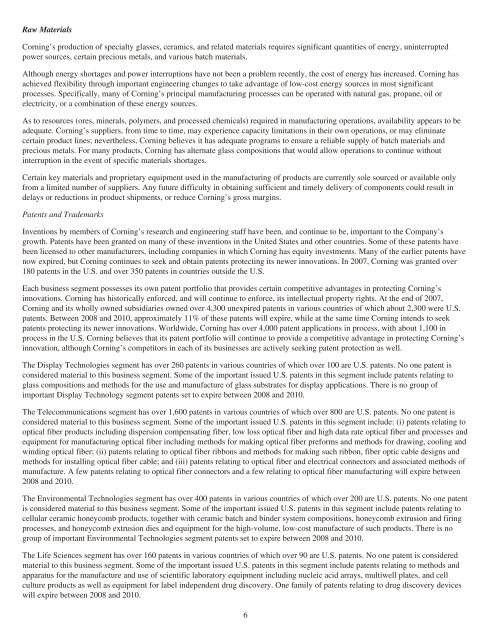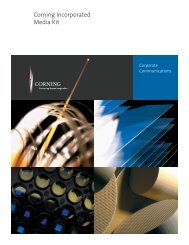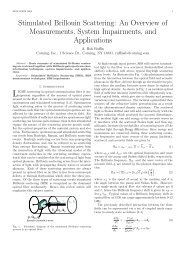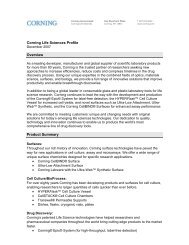You also want an ePaper? Increase the reach of your titles
YUMPU automatically turns print PDFs into web optimized ePapers that Google loves.
Raw Materials<br />
<strong>Corning</strong>’s production of specialty glasses, ceramics, and related materials requires significant quantities of energy, uninterrupted<br />
power sources, certain precious metals, and various batch materials.<br />
Although energy shortages and power interruptions have not been a problem recently, the cost of energy has increased. <strong>Corning</strong> has<br />
achieved flexibility through important engineering changes to take advantage of low-cost energy sources in most significant<br />
processes. Specifically, many of <strong>Corning</strong>’s principal manufacturing processes can be operated with natural gas, propane, oil or<br />
electricity, or a combination of these energy sources.<br />
As to resources (ores, minerals, polymers, and processed chemicals) required in manufacturing operations, availability appears to be<br />
adequate. <strong>Corning</strong>’s suppliers, from time to time, may experience capacity limitations in their own operations, or may eliminate<br />
certain product lines; nevertheless, <strong>Corning</strong> believes it has adequate programs to ensure a reliable supply of batch materials and<br />
precious metals. For many products, <strong>Corning</strong> has alternate glass compositions that would allow operations to continue without<br />
interruption in the event of specific materials shortages.<br />
Certain key materials and proprietary equipment used in the manufacturing of products are currently sole sourced or available only<br />
from a limited number of suppliers. Any future difficulty in obtaining sufficient and timely delivery of components could result in<br />
delays or reductions in product shipments, or reduce <strong>Corning</strong>’s gross margins.<br />
Patents and Trademarks<br />
Inventions by members of <strong>Corning</strong>’s research and engineering staff have been, and continue to be, important to the Company’s<br />
growth. Patents have been granted on many of these inventions in the United States and other countries. Some of these patents have<br />
been licensed to other manufacturers, including companies in which <strong>Corning</strong> has equity investments. Many of the earlier patents have<br />
now expired, but <strong>Corning</strong> continues to seek and obtain patents protecting its newer innovations. In <strong>2007</strong>, <strong>Corning</strong> was granted over<br />
180 patents in the U.S. and over 350 patents in countries outside the U.S.<br />
Each business segment possesses its own patent portfolio that provides certain competitive advantages in protecting <strong>Corning</strong>’s<br />
innovations. <strong>Corning</strong> has historically enforced, and will continue to enforce, its intellectual property rights. At the end of <strong>2007</strong>,<br />
<strong>Corning</strong> and its wholly owned subsidiaries owned over 4,300 unexpired patents in various countries of which about 2,300 were U.S.<br />
patents. Between 2008 and 2010, approximately 11% of these patents will expire, while at the same time <strong>Corning</strong> intends to seek<br />
patents protecting its newer innovations. Worldwide, <strong>Corning</strong> has over 4,000 patent applications in process, with about 1,100 in<br />
process in the U.S. <strong>Corning</strong> believes that its patent portfolio will continue to provide a competitive advantage in protecting <strong>Corning</strong>’s<br />
innovation, although <strong>Corning</strong>’s competitors in each of its businesses are actively seeking patent protection as well.<br />
The Display Technologies segment has over 260 patents in various countries of which over 100 are U.S. patents. No one patent is<br />
considered material to this business segment. Some of the important issued U.S. patents in this segment include patents relating to<br />
glass compositions and methods for the use and manufacture of glass substrates for display applications. There is no group of<br />
important Display Technology segment patents set to expire between 2008 and 2010.<br />
The Telecommunications segment has over 1,600 patents in various countries of which over 800 are U.S. patents. No one patent is<br />
considered material to this business segment. Some of the important issued U.S. patents in this segment include: (i) patents relating to<br />
optical fiber products including dispersion compensating fiber, low loss optical fiber and high data rate optical fiber and processes and<br />
equipment for manufacturing optical fiber including methods for making optical fiber preforms and methods for drawing, cooling and<br />
winding optical fiber; (ii) patents relating to optical fiber ribbons and methods for making such ribbon, fiber optic cable designs and<br />
methods for installing optical fiber cable; and (iii) patents relating to optical fiber and electrical connectors and associated methods of<br />
manufacture. A few patents relating to optical fiber connectors and a few relating to optical fiber manufacturing will expire between<br />
2008 and 2010.<br />
The Environmental Technologies segment has over 400 patents in various countries of which over 200 are U.S. patents. No one patent<br />
is considered material to this business segment. Some of the important issued U.S. patents in this segment include patents relating to<br />
cellular ceramic honeycomb products, together with ceramic batch and binder system compositions, honeycomb extrusion and firing<br />
processes, and honeycomb extrusion dies and equipment for the high-volume, low-cost manufacture of such products. There is no<br />
group of important Environmental Technologies segment patents set to expire between 2008 and 2010.<br />
The Life Sciences segment has over 160 patents in various countries of which over 90 are U.S. patents. No one patent is considered<br />
material to this business segment. Some of the important issued U.S. patents in this segment include patents relating to methods and<br />
apparatus for the manufacture and use of scientific laboratory equipment including nucleic acid arrays, multiwell plates, and cell<br />
culture products as well as equipment for label independent drug discovery. One family of patents relating to drug discovery devices<br />
will expire between 2008 and 2010.<br />
6







